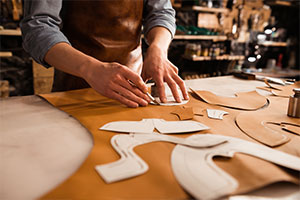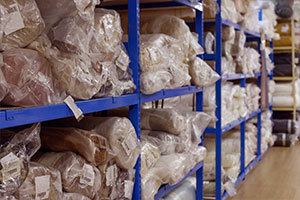If you want to buy a good leather handbag, you need to know about the different types of leather. The kind of leather affects how long your bag will last, how it looks, and how much it costs. In this article, I’ll explain the differences between top grain, whole grain, and genuine leather so you can make a smart purchase.
Top-grain, full-grain, and split-grain leather are higher quality than genuine leather. Genuine leather is a catch-all phrase that refers to all types of real leather but also to the bottom layer of leather that has been processed to be thin and smooth.
Now, let’s get into the nitty-gritty of each leather grade and what makes them special.
What’s the Difference Between Full Grain, Top Grain, and Genuine Leather?
The biggest difference between full-grain and genuine leather is the layers of skin they come from.
Full-grain leather comes from the top layer of skin that holds the structures together, while genuine leather can come from the layers under the top layer.
Another difference is in surface treatment.
Full-grain leather keeps the natural grain, while genuine leather often undergoes more processing for a smooth finish.

Full Grain Leather:
Full-grain leather is the best quality leather you can get.
It comes from the hide’s top layer and includes all the natural grain.
It’s not sanded or buffed to remove imperfections, so it keeps the original texture and markings of the animal’s hide.
Full-grain leather is known for its durability and strength. Over time, it develops a beautiful patina, which adds to its appeal.
Top Grain Leather:
Top-grain leather is also made from the hide’s top layer but has been sanded and refinished to remove imperfections.
This process gives top-grain leather a more uniform appearance than full-grain leather.
It’s still high quality and durable but not as strong as full-grain leather because it’s been altered.
However, top-grain leather is more stain-resistant and easier to maintain, which makes it a popular choice for handbags.

Genuine Leather:
Genuine leather is a broad term that can refer to any real leather, but it’s also used specifically to describe leather made from the lower layers of the hide.
This type of leather goes through more processing to get a smooth and uniform surface.
Genuine leather is less durable and less expensive than full-grain and top-grain leather.
It doesn’t develop the same patina and can wear out more quickly, but it’s still real leather and can be a good option for people on a budget.
What Are the 5 Grades of Leather?
Leather comes in five different grades, each with distinct characteristics that affect its durability, appearance, and cost.

Full-Grain Leather:
This is the best leather.
It’s made from the entire grain layer without removing the natural surface.
Full-grain leather is strong, durable, and develops a beautiful patina.
You’ll find it in high-end products like luxury handbags and furniture.
Top-Grain Leather:
The second-best, top-grain leather, is made from the hide’s top layer but has been sanded and refinished to remove imperfections.
It’s durable and easier to maintain than full-grain leather, so it’s a popular choice for all leather goods.
Split-Grain Leather:
This leather is made from the lower layers of the hide that remain after the top-grain layer is removed.
Split-grain leather isn’t as durable as full-grain and top-grain leather, so it’s often used in less expensive products. It might be coated or finished to make it look better.

Genuine Leather:
Genuine leather can mean any real leather, but it’s often used to describe lower-quality leather made from the layers below the top grain.
It’s been processed more and isn’t as durable as higher grades of leather.
You’ll find it in affordable leather goods.
Bonded Leather:
The lowest-quality leather, bonded leather, is made from leather scraps and fibers bonded with adhesives.
It’s not as durable or attractive as other types of leather, so you’ll typically find it in budget-friendly products.
What Grade of Leather is Genuine Leather?

Genuine leather is natural leather, but it’s not the best quality.
Regarding grading, genuine leather is often considered the lowest quality compared to full-grain and top-grain leather.
It’s made from the hidden layers left after separating the top grain.
Durability:
Genuine leather isn’t as durable as full-grain and top-grain leather.
It can wear out faster and might not withstand heavy use as higher-quality leather.
Appearance:
Genuine leather often has a more consistent appearance because of how it’s processed.
Although it lacks the natural texture and markings of full-grain leather, it can still look nice and comes in various finishes and colors.

Price:
Genuine leather is usually cheaper than full-grain and top-grain leather.
It’s a good option for people who want actual leather products without the higher cost of premium grades.
What are the Different Leather Grades?
Four main grades of leather are listed in order from best to worst: full-grain leather, top-grain leather, genuine leather, and bonded leather.
Full Grain Leather:
The best leather you can get is full-grain leather.
It’s the entire grain layer, so it’s the most durable and looks the best.
It’s what you’ll find in high-end products, and it develops a beautiful patina over time.

Top Grain Leather:
The next step down is top-grain leather.
It’s sanded and refinished to remove imperfections.
It’s still durable and easier to care for, so it’s used in a lot of different leather goods.
Genuine Leather:
The next step down is genuine leather.
It’s made from the layers below the top grain.
It’s more processed and not as durable, but it still has the look and feel of real leather at a lower price.
Bonded Leather:
The lowest quality leather is bonded leather.
It’s made from leather scraps and fibers bonded together with adhesives.
It’s not as durable or attractive as other types of leather, and you’ll typically find it in budget-friendly products.
How do you tell if the leather is full grain?

The way to tell if leather is full grain is to look for a few things.
Texture:
Full-grain leather has a natural, uneven texture with visible grains and imperfections.
It’s not sanded or buffed to remove flaws like other types of leather, so it looks more natural.
Patina:
One of the things that makes full-grain leather stand out is that it develops a beautiful patina over time.
This patina makes the leather look even better and is a sign of quality.
Thickness:
Full-grain leather is thicker and more durable than other leathers.
It feels substantial and strong, so you know it can take a beating.
Smell:
Full-grain leather smells different than lower-quality leather.
It has a rich, distinct smell because of the natural oils and minimal processing.

Feel:
When you touch full-grain leather, it should feel supple and luxurious.
The natural oils in the leather make it soft to the touch, and it will get even softer.
Full Grain vs Top Grain vs Genuine Leather
When shopping for a leather handbag, it helps to know the difference between full-grain, top-grain, and genuine leather.
Full-grain Leather:
Full-grain leather is the best, most expensive, and most durable.
It’s made from the entire grain layer and is tough and hard-wearing.
It develops a beautiful patina over time that adds to its character.
Full-grain leather is perfect for high-end products and people who want their leather to last and look good for years.
Top Grain Leather:
Top-grain leather is high-quality leather sanded and refinished to remove any imperfections.
It’s not quite as durable as full-grain leather, but it’s still strong and easy to maintain.
Top-grain leather looks more uniform and is often used in premium leather products that need to be consistent in appearance.

Genuine Leather:
Genuine leather is made from the layers of the hide that are below the top grain.
It’s more processed and less durable than full-grain and top-grain leather.
Genuine leather is a good choice if you want real leather products without paying full price.
It’s fine for everyday items but may not hold up as well if you use it heavily.
Leather Grades Chart
To better understand the differences, here is a summary chart of leather grades:
| Leather Grade | Quality | Characteristics | Durability | Common Uses |
|---|---|---|---|---|
| Full Grain | Highest | Natural grain develops a patina | Natural grain, develops a patina | Luxury handbags, high-end furniture |
| Top Grain | High | Sanded and refinished, uniform appearance | Very durable | Premium leather goods |
| Split Grain | Middle | Made from lower layers, less durable | Moderate | Budget-friendly products |
| Genuine | Lower | Highly processed, smooth surface | Less durable | Affordable leather goods |
| Bonded | Lowest | Made from leather scraps, least durable | Least durable | Budget products |
Understanding the different grades of leather is essential for making an informed decision when purchasing a leather handbag.
You can choose the best option that suits your needs and preferences by recognizing the unique characteristics of full grain, top grain, and genuine leather. Happy shopping!

